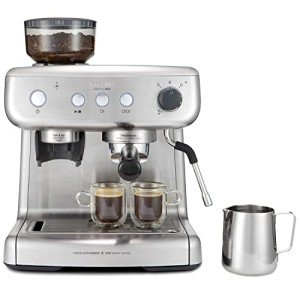The Secret Secrets Of Stainless Steel Espresso Machines

The Art of Italian Espresso Machines: A Brewed Tradition
Italian espresso machines are not simply appliances; they are an important part of Italy's rich coffee culture, representing a mix of artistry, engineering, and style. Coffee connoisseurs worldwide acknowledge the significance of high-quality espresso, a staple of Italian life and food. This post checks out the history, mechanics, types, and elements to consider when buying an Italian espresso machine, showing the depth of this cherished beverage and its brewing approaches.
History of Espresso Machines
The espresso machine's advancement dates back to the early 20th century in Italy, where coffee was not simply a beverage however a vital social routine. The preliminary efforts to brew espresso begun with basic, stove-top models, gradually developing into intricate machines that might replicate the best brew.
- 1901-- The First Espresso Machine: The first steam-powered espresso machine, called the "Ideale," was developed by Luigi Bezzera. This machinery marked a turning point in espresso developing.
- 1938-- The Lever Machine: The intro of the lever machine made it simpler to manage the pressure utilized in espresso extraction, improving flavor consistency.
- 1947-- The Automatic Machine: Reaching more consumers, Gaggia released the very first automatic espresso machine, additional popularizing espresso bars.
- 2007-- The Digital Age: Technological advancements resulted in the birth of fully programmable machines, enabling users to customize their brewing settings to attain an individualized coffee experience.
Secret Features of Italian Espresso Machines
Italian espresso machines embody accuracy, workmanship, and innovation. Here are some crucial components that highlight their significance:
| Feature | Description |
|---|---|
| Boiler Type | Determines how heat is created and kept. this site consist of single boiler, dual boiler, and heat exchanger. |
| Group Heads | Where the coffee is brewed; commercial machines often have multiple group heads for effectiveness. |
| Pressure Control | Vital for accomplishing the ideal espresso; most machines run at 9 bars of pressure. |
| Frothing Capabilities | The steam wand permits milk frothing, vital for beverages like cappuccino and latte. |
| Build Quality | The materials used (stainless steel, brass, etc) influence durability and heat retention. |
Kinds Of Italian Espresso Machines
Picking the ideal machine hinges on user choices, budget, and meant use. Below are the main types of Italian espresso machines:
Manual Espresso Machines
- Pros: Offer complete control over the developing procedure, enabling a tailored touch.
- Cons: Require skill and practice, can be labor-intensive.
Semi-Automatic Machines
- Pros: Provide a balance in between automated and manual procedures; users manage water flow.
- Cons: Can have a steeper knowing curve than fully automatic machines.
Completely Automatic Machines
- Pros: Simplify the brewing process with push-button operations; suitable for beginners.
- Cons: May compromise a few of the subtleties of manual brewing.
Super-Automatic Machines
- Pros: Grind, tamp, brew, and froth immediately; hassle-free for hectic way of lives.
- Cons: Less control over the developing variables, capacity for a less authentic espresso experience.
Buying Guide: Factors to Consider
Picking the ideal Italian espresso machine can be daunting, but thinking about the following factors can simplify the decision-making process:
- Budget: Italian espresso machines range from affordable to high-end models, so set a budget upfront.
- Usage Frequency: Evaluate how frequently you will use the machine; daily users might want a more long lasting alternative.
- Area: Measure your kitchen area or counter area; some machines can be large and require sufficient clearance.
- Maintenance: Consider ease of cleaning; machines with detachable parts or integrated cleansing functions may decrease maintenance.
- User Skill Level: Beginners may choose fully or semi-automatic machines, while experienced baristas can handle manual machines.
- Brand name Reputation: Research brand names known for quality, such as Breville, Gaggia, and La Marzocco.
Popular Italian Espresso Machine Brands
Italian craftsmanship is renowned for producing a few of the very best espresso machines worldwide. Here are top brands worth considering:
- Gaggia: Known for its home espresso machines and price.
- La Marzocco: A superior brand name understood for its commercial-grade machines and innovative technology.
- Rancilio: Renowned for its resilient construct and professional-quality machines suitable for home and commercial use.
- Sage/Breville: Offers advanced features and easy to use designs, best for both beginners and enthusiasts.
Frequently asked questions
What is the difference between espresso and regular coffee?
Espresso is a concentrated coffee brewed by forcing hot water through finely-ground coffee under pressure. It has a thicker consistency, richer flavor, and higher caffeine concentration than routine coffee.
Can I make milk-based beverages with an espresso machine?
Yes, numerous Italian espresso machines feature a steam wand to froth milk for drinks like cappuccinos, lattes, and macchiatos.
How frequently should I clean my espresso machine?
Routine upkeep is necessary. Typically, an extensive cleaning is advised every few weeks, while descaling should be done every 1 to 3 months, depending upon water solidity.
What is the perfect pressure for developing espresso?
The ideal pressure for developing espresso is around 9 bars. This pressure makes sure the ideal extraction of flavors from the coffee premises.
Are more costly machines worth the investment?
Higher-end machines often utilize much better materials and technology, offering improved resilience and more constant outcomes. For serious coffee enthusiasts, purchasing a great machine can elevate the espresso experience considerably.
Italian espresso machines are far more than simple developing devices; they are a celebration of a cultural tradition that has actually affected coffee intake worldwide. With different designs readily available to fit any user's needs-- ranging from newbies to skilled baristas-- there is an Italian espresso machine completely fit for everybody. As you start your espresso journey, comprehending the history, mechanics, and options will enhance your experience and appreciation for this time-honored beverage. Whether you seek to recreate a café ambiance in the house or fine-tune your developing method, these machines can providing memorable cups of espresso embellished with the abundant history of Italian coffee culture.

